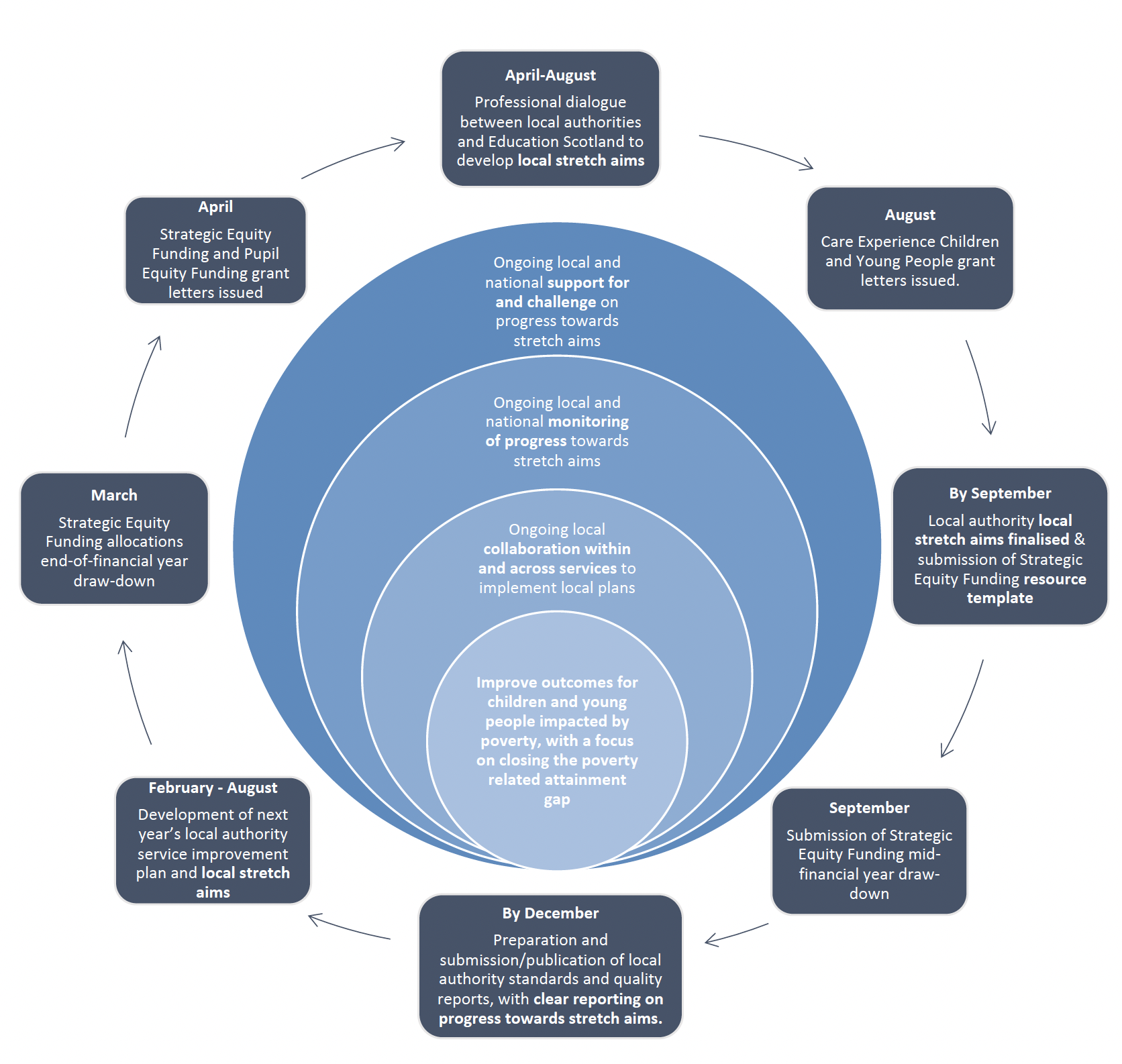Scottish Attainment Challenge: framework for recovery and accelerating progress
A Framework to support schools, local authorities and others across the education system to support educational recovery and increase progress in improving outcomes for children and young people impacted by poverty.
3. Reporting and monitoring
3.1 In-year monitoring of progress
It is important that in-year monitoring of progress occurs in local settings to ensure an ongoing understanding of progress. This enables early support and intervention where required. This already happens in most schools and authorities and should be a key part of local approaches.
Monitoring of progress will be part of the on-going and regular dialogue between local authorities and Education Scotland, through the Senior Regional Advisors and Attainment Advisors in particular.
Through the Scottish Attainment Challenge joint programme Scottish Government and Education Scotland will discuss local progress in improving health and wellbeing and tackling the poverty-related attainment gap quarterly. This will be informed by national data, evidence and intelligence and attainment advisor reporting to ensure appropriate levels of support are provided and that the best possible progress and outcomes are being achieved.
These quarterly progress discussions will be an opportunity to reflect on successes, wider barriers to progress and the types of support, collaboration and challenge required to help ensure future progress across all local authorities. Support will be offered and provided using a staged approach:
- Universal support will be available to all local authorities and schools.
- Targeted support will be provided to local authorities and schools with the most need. This may be those with the highest levels of poverty or others depending on the data and contextual analysis.
- Intensive support will be provided to local authorities and schools where there is a consistent barrier and no, or very limited, progress is being made to improving outcomes for children and young people affected by poverty.
As is set out in the 2018 Joint Agreement, in rare cases where evidence suggests there is cause for concern, the following approaches will be deployed as appropriate:
- professional dialogue between LA and ES will have explored concerns about limited progress and a variety of supports provided
- continued concerns will be shared with all partners
- the SNCT will collectively address concerns if there is evidence of non-compliance by local authorities with the Code of Practice on staff selection
- COSLA will facilitate challenge and support drawing in expertise from ADES/ES and others. This will include evidence review and challenge sessions leading to a clear action plan, offer of peer support and follow-up activity to monitor impact and improvement
- evaluation of progress
- clear line of escalation to audit and scrutiny inspection bodies if insufficient progress.
3.2 Reporting
Reporting on the impact of plans to use education to improve outcomes for children and young people impacted by poverty, with a focus on reducing the poverty-related attainment gap will be through existing mechanisms within the education system.
Schools
In line with arrangements for Pupil Equity Funding since its roll-out in 2017/18, schools are expected to incorporate details of their Pupil Equity Funding plans and explicitly report on the impact on outcomes for learners impacted by poverty within existing reporting processes to their Parent Council and Forum, including in their annual Standards and Quality Reports.
These reports should be made publicly available so that parents can understand what is happening in their school.
Scottish Government and Education Scotland will sample these reports annually to continue to inform our understanding of the approaches to tackling the poverty-related attainment gap.
Key findings from this sampling will be made available to local authorities and schools.
Agreeing local stretch aims
Reporting should be done through the existing requirement for local authority Education Standards and Quality Reports (or local equivalent reports). These reports, whilst covering the overall progress and impact of local authority service improvement plans and school improvement plans, should for the Scottish Attainment Challenge (considering the impact across all funding streams) have specific details on:
- the original stretch aims set out in the local authority education service improvement plan and the extent to which they have been achieved;
- the measures described in the local authority education service improvement plan and any additional data to report on the impact on children and young people affected by poverty. Both qualitative and quantitative data should be used to detail whether the expected impact was achieved – with clear quantitative progress against the NIF measures included; and
- examples of supports and interventions which have been effective.
There should be clear narrative on how Attainment Scotland Funding (PEF, SEF and CECYP funding) contributed to local approaches to meeting locally identified stretch aims. There should be evidence of strategic coherence and alignment to the use of these funding streams.
Local authorities should share reporting on progress with Scottish Government and Education Scotland by the end of December annually. This can be via their annually published improvement reports (for which education authorities have an existing duty to provide Scottish Ministers a copy once published).
For CECYP funding, arrangements will continue as they have done since its roll-out in 2018/19 as part of existing relevant authority reporting requirements, with reports shared with the Scottish Government and Education Scotland at the end of the academic year, highlighting evidence of impact through both qualitative and quantitative information. Separate CECYP guidance sets this out in full.

Contact
There is a problem
Thanks for your feedback